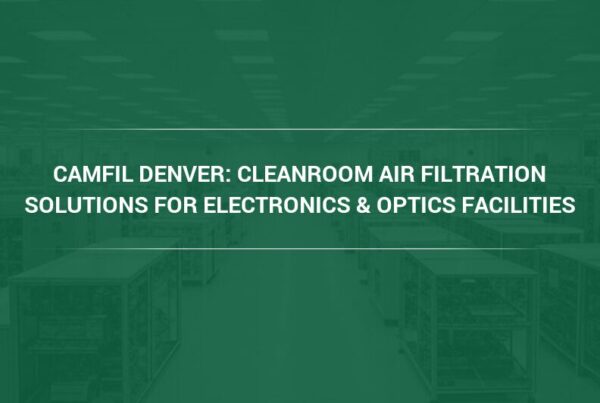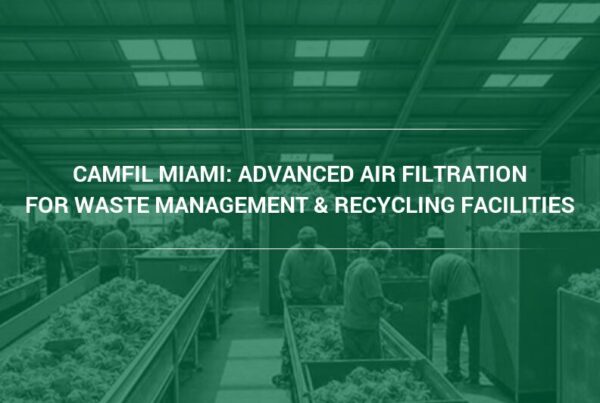Learn how one study found that poor outdoor and indoor air quality can increase the risk of oral cancer, and how replacing your air filters can help.
Cancer Awareness –New research from Taiwan suggests that high levels of air pollution are linked to a higher risk of developing oral cancer, showing that air filters may have more benefits than previously thought.
“Scientists have already established the connection between air pollution and a host of health problems, including respiratory issues like asthma and emphysema, structural changes in the heart, and even an increased risk of dementia,” said Camfil USA’s Charlie Seyffer, Manager of Marketing & Technical Materials for commercial air filters and 37-year ASHRAE member and active committee participant. “These studies all point toward the same truth that there is no such thing as a ‘safe’ level of air pollution.”
Now an increasing number of researchers are saying that very high concentrations of air pollution has a correlation with a higher incidence of mouth cancer. The study, published in the Journal of Investigative Medicine, describes how Taiwanese researchers found the association by analyzing air quality data gathered from 66 air pollution monitoring stations across Taiwan in 2000.
Between 2012 and 2013, they cross-referenced this with the health records of more than 482,659 men that were over age 40 and who had availed of preventive health services and provided information about their smoking and betel nut chewing.
During this same period, 1,617 cases of mouth cancer were diagnosed among the research participants. Not surprisingly, frequent smoking and betel nut chewing were linked to increased risk of mouth cancer. But so too were higher levels of exposure to fine particulate matter, or PM2.5—particles no larger than 2.5 microns in diameter.
Another Study Linking Particulate Matter to Poor Outdoor and Indoor Air Quality
This study’s findings add to the growing body of literature about the dangers of fine particulate matter (PM) on outdoor and indoor air quality.
For this study, the researchers focused on the men’s exposure to fine particulate matter based on their location in the country. Afterwards, the men were categorized into four groups, from lowest to high levels of air pollution exposure.
After factoring in things like age, smoking and betel chewing, and exposure to ozone and other types of particulate matter, the researchers found that men who were constantly exposed to the highest levels of PM2.5 had a high risk of developing mouth cancer.
More specifically, when compared with men who were exposed to average annual PM2.5 concentrations of 26.74 micrograms per cubic meter of air, men who were exposed to 40.37 μg/m3 or more had up to 43 percent greater odds of developing the cancer.
Global Impact of Particulate Matter Highlights Importance of Air Purifiers
The World Health Organization (WHO) has previously stated that average annual concentrations of PM2.5 should not go beyond 10 μg/m3. While annual PM2.5 levels in western urban centers like London, New York and Los Angeles have been found to exceed this standard, they are still much lower than the worst PM levels observed in the Taiwanese study.
While the problem of particulate matter (PM) pollution is one that affects almost all countries, it is especially pronounced in the developing world. According to data from the WHO, the average annual concentrations of PM2.5 in Delhi is a whopping 122 μg/m3, 86 μg/m3 in Kabul, and 85 μg/m3 in Beijing.
The increased risk of developing diseases from PM2.5 exposure is something that’s no longer a secret.
“PM2.5 is especially dangerous because it is small enough to reach the smallest airways of the lungs, depositing themselves in the alveoli,” explained Seyffer. “From here, the PM can enter the bloodstream and reach the body’s vital organs, causing a host of health issues.”
This may explain why exposure to air pollution has also been linked to higher risk of diabetes, Alzheimer’s disease, and even autism spectrum disorder in the prenatal stage of children.
Reducing the Risk of PM-caused Cancer with Air Purification Systems
The researchers also note that certain components of PM2.5 such as heavy metals and volatile organic compounds (VOCs) like polycyclic aromatic hydrocarbons are known carcinogens, which may be the reason why air pollution exposure is linked to cancer. As for why PM2.5 represents the greatest risk to human health, the smaller diameter of these particles, combined with the larger surface area they cover, means it’s very easy for them to be inhaled and wreak havoc on the body. Still, it remains to be seen how much of an impact air purification systems can have on reducing the risk of certain cancers.
Aside from particulate matter, the researchers also found a significant link between exposure to ground-level ozone levels between 28.69-30.97 parts per billion. Ozone is a known irritant of the lungs and airways. This invisible gas also contributes to the formation of smog in the atmosphere and, subsequently, acid rain. Ozone can react with other pollutants in the atmosphere to generate particulate matter.
Limitations of Study Do Not Negate Value of Commercial Air Filtration Systems
It should be pointed out, however, that this is an observational study, so it can’t be used to establish cause. For starters, it does not consider the research participants’ level of exposure to air pollution through their entire lives, which can easily be lower or higher than the level of exposure during the researchers’ observation period. The researchers were also careful to note that they did not have enough data to look at how much PM2.5 enters the mouth, which could have made a stronger correlation between the pollutant and oral cancer. Likewise, the findings of this study must be duplicated in other countries to establish stronger links. Still, these limitations don’t take away from the importance of commercial air filtration systems on human health.
Air pollution has long been linked with multiple forms of cancer, including pancreatic, liver, breast, and lung cancer, which means that good air quality is now a necessity in terms of overall health.
And if someone in your household has existing health problems like asthma and heart disease, the need for clean air is even greater. In this case, you have a more urgent need to install home air filters to protect their health.
Work with a Reliable Air Filter Manufacturer to Have the Best Air Filter Solutions
Whether you need an air filtration system for home, commercial, or municipal applications, it’s important to choose one with the help of a trusted air filter manufacturer. Camfil USA can recommend the ideal air filtration solution for your industry based on factors such as:
- The size of the indoor spaces requiring air purification
- The most common types of airborne pollutants present
- Existing challenges, such as lack of ventilation, presence of radon gas, volume of foot traffic
For example, if the most common type of airborne pollutant is particulate matter, you are better off attaching high efficiency filtration systems to your HVAC unit. High efficiency filters are specifically designed to capture PM down to the sub-micron size range, including those lung-damaging particles. On the other hand, if you have high concentrations of gaseous pollutants and volatile organic carbons (VOCs) from chemicals, cleaning products, and machinery, you can use an activated carbon filter, which is designed to absorb gases.
For more information about the different types of air filter products offered, get in touch with Camfil USA. Our team will be happy to answer all of your questions about maintaining good indoor air quality in homes, commercial buildings, offices, schools, hospitals, or any other facility.
Lynne Laake
Camfil USA Air Filters
T: 888.599.6620
B: Browse Camfil Air Filtration News
F: Friend Camfil USA on Facebook



